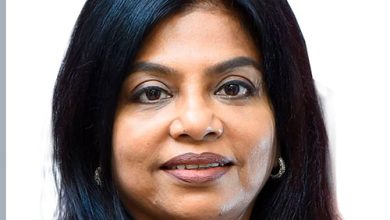FINANCE SECTOR
Compiled by Yamini Sequeira
NEW PAYMENT ARCHITECTURE
Channa de Silva calls for technology to deliver customer convenience

Q: How has Sri Lanka fared in the race to modernise its payment infrastructure?
A: Sri Lanka has consistently been at the forefront when it comes to pioneering unique payment systems.
It was the first in the region to introduce the Sri Lanka Interbank Payment System (SLIPS) in 1994 as an offline electronic fund transfer system. SLIPS automated periodic and bulk payments such as salaries and utility bills, and replaced the manual process of issuing cheques for payments.
Next, the Common Card and Payment Switch (CCAPS) increased interbank transaction volumes by connecting local ATMs. This reduced transaction costs for customers who use ATMs of banks other than their own. Except for around 20 ATMs, 96 percent of them are interconnected.
Compared to certain leading economies, Sri Lanka is a relatively early adopter of a cheque imaging and truncation system, which reduced the realisation time – from between five and seven days to the next business day – by using images that were electronically transferred by banks.
The UK launched this system in 2017 while Sri Lanka did so in 2006. Real-time payments, which were introduced in 2015, represent another milestone that has accelerated the use of electronic transactions.
Q: What has the pace of adoption been like?
A: Services have gained traction with almost 23 million bank accounts for a population of 21 million. Approximately 75 percent of the citizenry have bank accounts. Unfortunately, many people do not use bank accounts for transactions.
Even in the US, the ‘population-bank accounts ratio’ is lower than in Sri Lanka where parents open accounts for children, which may explain the higher penetration.
Q: How do you view prospects for mobile wallets?
A: The mobile wallet does not have much take-up in Sri Lanka since most citizens are banked – unlike in other markets where people don’t have bank accounts and ATMs are limited.
In such locations, mobile cash is the only option unlike in this country where there’s a branch of a bank or an ATM at just about every corner. The recipient not having the same type of mobile wallet to receive a payment is also a hindrance.
Q: What plans are in the pipeline for the next 12 months or so?
A: Banks will soon introduce nicknames for bank accounts to facilitate fund transfers. By providing the correct nickname to the person transferring funds, people can receive monies directly to their accounts without disclosing any details. This peer-to-peer mode of payment will go live shortly and is expected to catch on.
Q: How would you describe the credit and debit card spheres?
A: Sri Lanka has issued approximately 23 million debit cards but only 1.7 million credit cards, which is possibly due to banks not considering most citizens to be creditworthy.
In Sri Lanka, people use debit cards primarily to withdraw and pay with cash instead of opting for electronic payments. Almost 80 percent of cash withdrawals are below Rs. 10,000; therefore, a majority of retail payments are by way of cash.
A country can be considered ‘e-commerce friendly’ if credit card penetration is around 40 percent, which is perhaps why online payment systems such as PayPal aren’t present in Sri Lanka. Although 65,000 POS terminals are available in and around the island, on average there are fewer than four transactions a day for every terminal, which reflects low adoption. Either POS terminals are not adequate or the commissions charged from merchants are too high.
These are inherent barriers to encouraging greater use of credit and debit cards.
Q: So what are the solutions, in your view?
A: LANKAQR codes and nicknames are two solutions, whereby customers with smartphones can scan and pay whereas merchants do not need POS terminals.
The aim is to convert 20 percent of cash payments into electronic transactions. By adopting new solutions, banks can offer access to low-cost digital payments and improve customer convenience.
Q: And how do you perceive the proliferation of fintech?
A: Fintech has changed the dynamics of payments by catering to an underlying consumer need. For example, startups have provided solutions to offer vehicle rides at customers’ doorsteps.
The public might not have felt this to be a need but adoption is high because it promises convenience. The banks come up with payment apps but may not look to address people’s daily needs. A technology solution should address a consumer need first and the payment option can follow seamlessly as a byproduct.
Q: Could you outline the latest trends?
A: We are witnessing a shift to apps that enhance customer lifestyles. Millennials and gen Z are driving this trend by using feature-rich smartphones. And technology that provides convenience and speed will witness greater adoption. QR codes and peer-to-peer payment systems are bound to become more popular.
Sri Lanka Customs accepts online payments while the Inland Revenue Department (IRD) will go online soon – this is a major step. Overall, fintech companies are the ones to watch as they make technology a part of customers’ lives. Adoption would increase when people seek apps to resolve burning issues.







